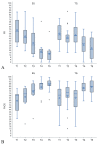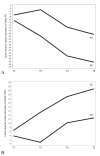Myofascial points treatment with focused extracorporeal shock wave therapy (f-ESWT) for plantar fasciitis: an open label randomized clinical trial
- PMID: 34786906
- PMCID: PMC9980534
- DOI: 10.23736/S1973-9087.21.06814-3
Myofascial points treatment with focused extracorporeal shock wave therapy (f-ESWT) for plantar fasciitis: an open label randomized clinical trial
Abstract
Background: Plantar fasciitis (PF) is a common cause of heel pain. Among the several conservative treatment options, extracorporeal shock wave therapy (ESWT) is considered the standard treatment. However, recent studies suggest that PF may be sustained by a myofascial impairment proximal to the pain area with a biomechanical disequilibrium of the entire limb and pelvis.
Aim: By combining the concepts of fascial manipulation and ESWT, the purpose of this study was to evaluate the effectiveness of the ESWT on myofascial points in a sample of subjects with PF.
Design: Open label randomized controlled clinical trial.
Setting: Outpatient clinic.
Population: Patients with PF were randomly assigned to an experimental treatment group (EG), treated with focused ESWT on myofascial points, and a control group (CG), treated with the focused ESWT traditional approach on the medial calcaneal tubercle.
Methods: Every patient underwent a 3-session program and follow-up after 1 and 4 months. Outcome measures included the Foot and Ankle Outcome Score (FAOS) and the Italian Foot Functional Index (17-iFFI).
Results: Thirty patients were enrolled in the study. Four patients of the CG dropped out the study, therefore twenty-six patients were included in the final analysis. Improvement in 17-iFFI and FAOS scores was observed in both groups starting from the third treatment and confirmed at the 1-month and 4-month follow-ups, with earlier improvement in the score values observed in the EG.
Conclusions: Treatment of the myofascial points with ESWT in subjects suffering from plantar fasciitis could be an effective treatment option. It fosters the hypothesis that a global biomechanical re-equilibrium of the body would be necessary to completely solve the pathology.
Clinical rehabilitation impact: ESWT on myofascial points could provide an interesting alternative with better outcomes in terms of time needed for recovery compared to traditional ESWT for the conservative management of PF.
Conflict of interest statement
Figures




Similar articles
-
Comparison of effectiveness of extracorporeal shock wave therapy and peloidotherapy in patients with plantar fasciitis: a prospective, randomized, controlled study.Int J Biometeorol. 2025 Jan;69(1):17-28. doi: 10.1007/s00484-024-02787-2. Epub 2024 Sep 23. Int J Biometeorol. 2025. PMID: 39311965 Clinical Trial.
-
Comparing Myofascial Pain Syndrome Treatment with Dry Needling Versus Extracorporeal Shock Wave Therapy for Plantar Fasciitis on Pain and Function of the Heel.J Foot Ankle Surg. 2024 Jul-Aug;63(4):477-481. doi: 10.1053/j.jfas.2024.02.008. Epub 2024 Mar 12. J Foot Ankle Surg. 2024. PMID: 38484790 Clinical Trial.
-
Comparison of extracorporeal shock wave therapy with botulinum toxin type A in the treatment of plantar fasciitis.Disabil Rehabil. 2016 Oct;38(21):2114-21. doi: 10.3109/09638288.2015.1114036. Epub 2016 Mar 1. Disabil Rehabil. 2016. PMID: 26930375 Clinical Trial.
-
Clinical effects of extracorporeal shock-wave therapy and ultrasound-guided local corticosteroid injections for plantar fasciitis in adults: A meta-analysis of randomized controlled trials.Medicine (Baltimore). 2018 Dec;97(50):e13687. doi: 10.1097/MD.0000000000013687. Medicine (Baltimore). 2018. PMID: 30558080 Free PMC article.
-
Effectiveness of Extracorporeal Shock Wave Therapy Without Local Anesthesia in Patients With Recalcitrant Plantar Fasciitis: A Meta-Analysis of Randomized Controlled Trials.Am J Phys Med Rehabil. 2017 Aug;96(8):529-534. doi: 10.1097/PHM.0000000000000666. Am J Phys Med Rehabil. 2017. PMID: 27977431 Review.
Cited by
-
Evaluation of the efficacy of trigger points combined with extracorporeal shock waves in the treatment of plantar fasciitis: heel temperature and plantar pressure.BMC Musculoskelet Disord. 2024 Mar 2;25(1):191. doi: 10.1186/s12891-024-07296-2. BMC Musculoskelet Disord. 2024. PMID: 38431558 Free PMC article.
-
Global trends in research on extracorporeal shock wave therapy (ESWT) from 2000 to 2021.BMC Musculoskelet Disord. 2023 Apr 20;24(1):312. doi: 10.1186/s12891-023-06407-9. BMC Musculoskelet Disord. 2023. PMID: 37081473 Free PMC article.
-
Small needle-knife versus extracorporeal shock wave therapy for the treatment of plantar fasciitis: A systematic review and meta-analysis.Heliyon. 2024 Jan 6;10(1):e24229. doi: 10.1016/j.heliyon.2024.e24229. eCollection 2024 Jan 15. Heliyon. 2024. PMID: 38234920 Free PMC article.
-
Efficacy and tolerability of extracorporeal shock wave therapy in patients with plantar fasciopathy: a systematic review with meta-analysis and meta-regression.Eur J Phys Rehabil Med. 2024 Oct;60(5):832-846. doi: 10.23736/S1973-9087.24.08136-X. Epub 2024 Sep 11. Eur J Phys Rehabil Med. 2024. PMID: 39257331 Free PMC article.
-
The Use and Benefits of Focused Shockwaves for the Diagnosis of Myofascial Pain Syndrome by Examining Myofascial Trigger Points in Low Back Pain.Biomedicines. 2024 Dec 20;12(12):2909. doi: 10.3390/biomedicines12122909. Biomedicines. 2024. PMID: 39767813 Free PMC article.
References
-
- Wearing SC, Smeathers JE, Urry SR, Hennig EM, Hills AP. The pathomechanics of plantar fasciitis. Sports Med 2006;36:585–611. https://www.ncbi.nlm.nih.gov/entrez/query.fcgi?cmd=Retrieve&db=PubMed&l... 10.2165/00007256-200636070-00004 - DOI - PubMed
-
- Hammer DS, Adam F, Kreutz A, Rupp S, Kohn D, Seil R. Ultrasonographic evaluation at 6-month follow-up of plantar fasciitis after extracorporeal shock wave therapy. Arch Orthop Trauma Surg 2005;125:6–9. https://www.ncbi.nlm.nih.gov/entrez/query.fcgi?cmd=Retrieve&db=PubMed&l... 10.1007/s00402-003-0591-z - DOI - PubMed
-
- Martin RL, Davenport TE, Reischl SF, McPoil TG, Matheson JW, Wukich DK, et al. American Physical Therapy Association . Heel pain-plantar fasciitis: revision 2014. J Orthop Sports Phys Ther 2014;44:A1–33. https://www.ncbi.nlm.nih.gov/entrez/query.fcgi?cmd=Retrieve&db=PubMed&l... 10.2519/jospt.2014.0303 - DOI - PubMed
-
- Barrett SJ, O’Malley R. Plantar fasciitis and other causes of heel pain. Am Fam Physician 1999;59:2200–6. https://www.ncbi.nlm.nih.gov/entrez/query.fcgi?cmd=Retrieve&db=PubMed&l... - PubMed
-
- Benjamin M. The fascia of the limbs and back—a review. J Anat 2009;214:1–18. https://www.ncbi.nlm.nih.gov/entrez/query.fcgi?cmd=Retrieve&db=PubMed&l... 10.1111/j.1469-7580.2008.01011.x - DOI - PMC - PubMed
Publication types
MeSH terms
LinkOut - more resources
Full Text Sources

